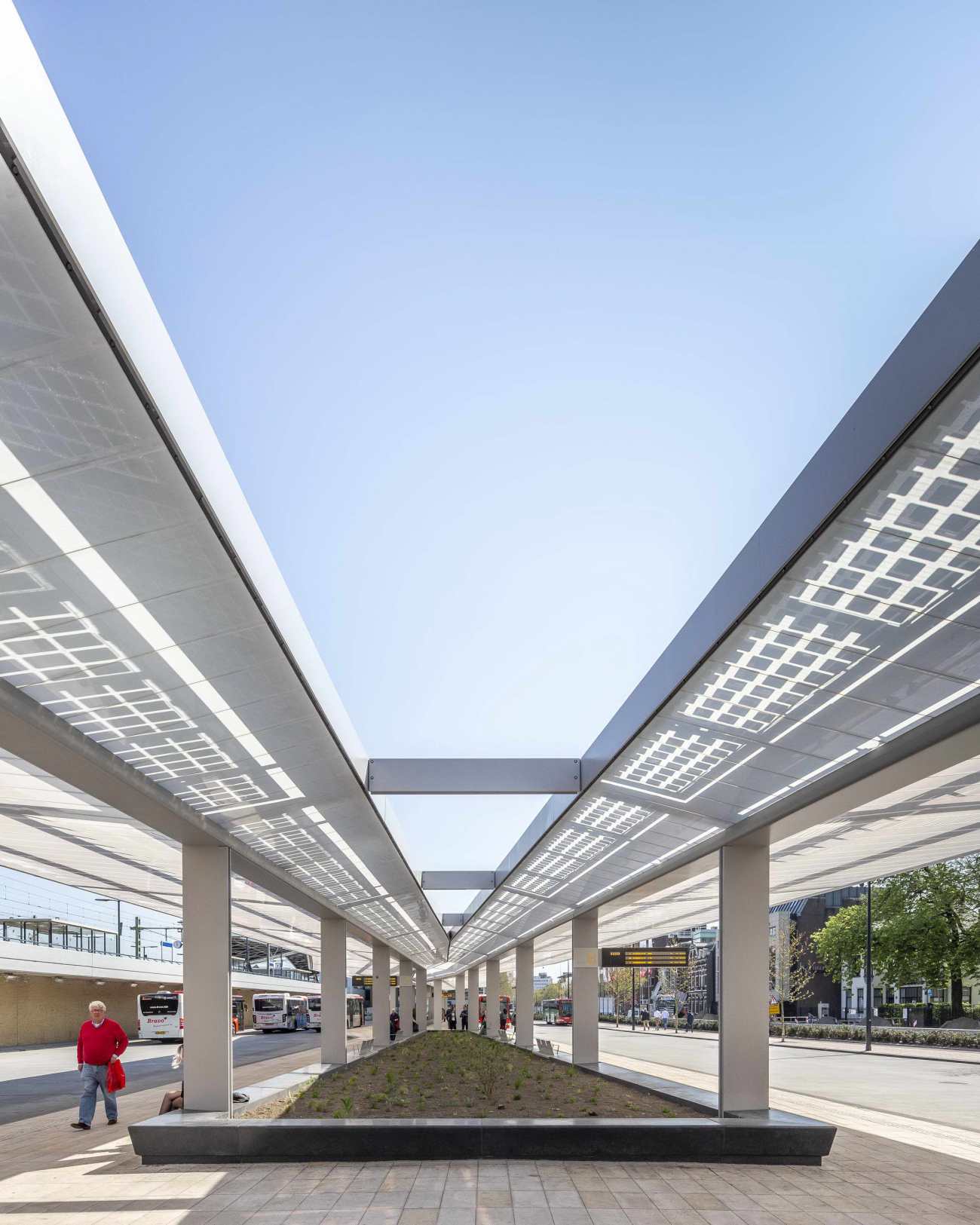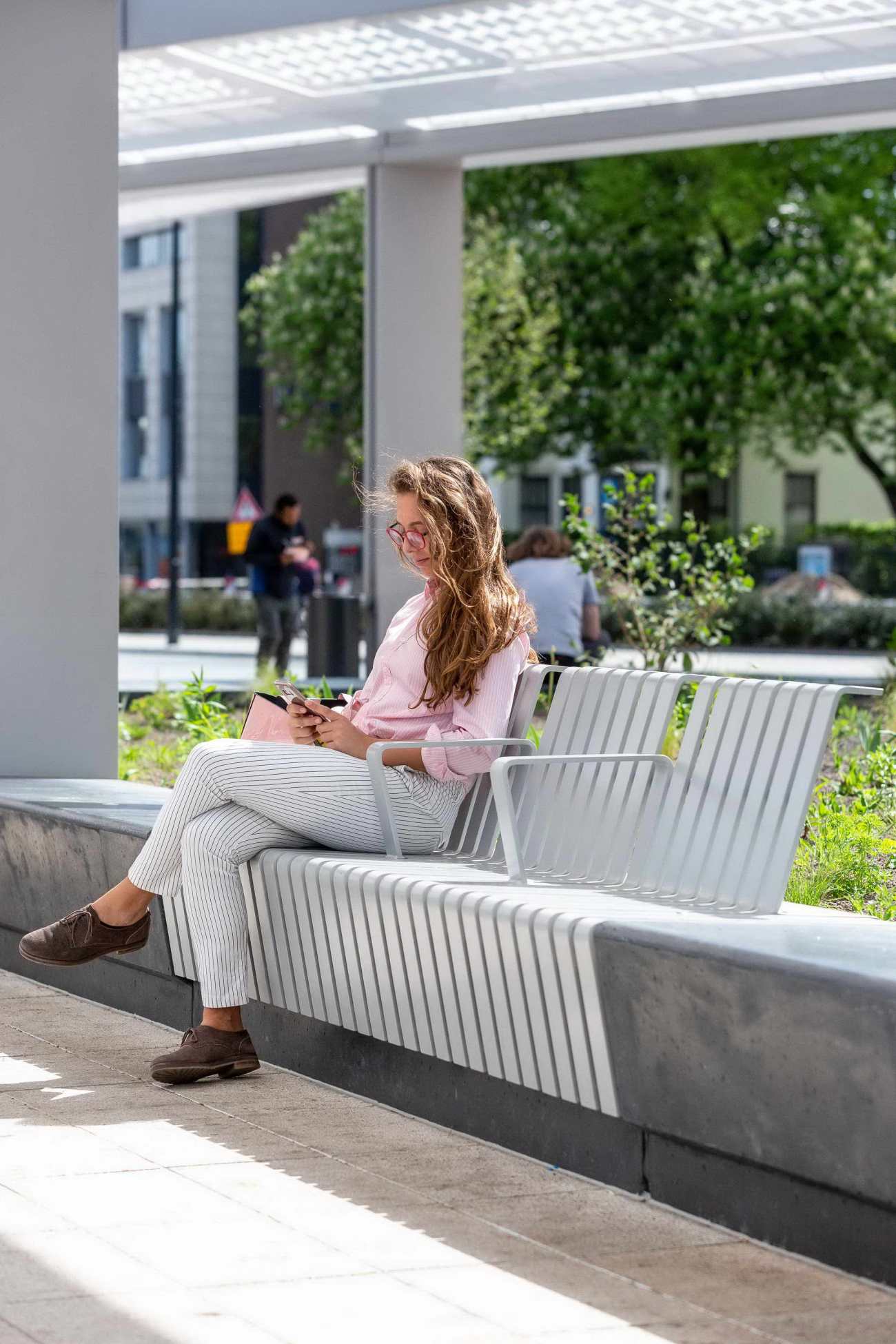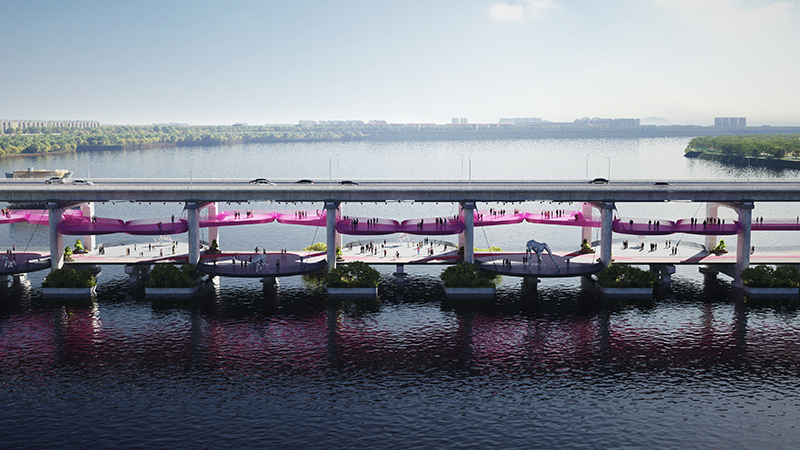蒂尔堡的新公交站投入使用。就像火车站的改造和铁路区的新自行车停车场一样,公交站也是由cepezed事务所设计的。新的公共交通设施产生了自己的能量,其设计是彻底的一体化。新汽车站是蒂尔堡公共交通枢纽大规模振兴的一部分。它完全是为旅客的舒适度和清晰愉快的交通流而设计的。该设施位于火车站的西侧,大致位于前汽车站的位置,但在最西侧包括了前Tilburion公寓楼的位置。
Recently, the new bus station in Tilburg was taken into use. Just like the renovation of the train station and the new bicycle parkings in the railway zone, the bus station was designed by cepezed architects. The new public transport facility generates its own energy and its design is thoroughly integrated. The new bus station is a part of the large-scale revitalization of the Tilburg public transport hub. It is fully tailored to the comfort of the travellers and to a clear and pleasant traffic flow. The facility is situated on the west side of the train station, roughly at the place that also occupied the former bus station, but with the location of the former Tilburion apartment block included on the far west side.
极简的结构
基本设置包括一系列非常薄的柱子,上面有一个均匀的简约的遮阳篷结构。该建筑形成了一个三角形的回路,长度超过160米,中心有一个开放空间。公交车的位置被安排在外侧;六个用于上车,一个用于下车。遮阳篷的宽度从14米到30米不等,这些主要是功能性的,与城市环境相一致,但在视觉上,它们也与火车站的纪念性屋顶结构产生了优雅的共鸣。这也有一个衔接的结构,而且似乎是漂浮的,就像公共汽车站的遮阳篷。其他空间将整体结构分为三部分。在每个部分的中心,都有绿色植被,周围是供旅客休憩的边缘。在电路的宽端,中心还包含一个亭子。这里有巴士司机的员工食堂、公共交通服务点和一个商业空间,其功能尚待确定。一个高架露台与这个商业空间相邻。
Minimalistic circuit
The basic setup consists of a series of very thin columns with an evenly minimalistic awning structure on top of them. The construction forms a triangular circuit with a length of over 160 meters and an open space in the centre. The bus positions are arranged around the outer side; six for boarding and one for deboarding. The awning circulation runs from 14 to 30 meters width in total and has two offsets in its contour. These are primarily functional and align with the urban context, but visually, they also resonate elegantly with the monumental roof structure of the train station. This also has an articulated structure and moreover seems to float, just like the bus station awning. The setoffs divide the overall structure into three segments. In the centre of every segment, there is green plantation surrounded by a sitting edge for the travellers. On the wide end of the circuit, the centre additionally contains a pavilion. This houses a staff canteen for the bus drivers, a public transport service point and a commercial space that has to find its function yet. An elevated terrace adjoins this commercial space.
带光伏板和ETFE的遮阳篷
周围宽敞的遮阳篷完全覆盖了公共汽车站台,另外还有部分公共汽车。因此,旅客总是可以在避雨的情况下登机和下船。该结构由一个覆盖着ETFE薄膜的钢框架组成。照明设备被安装在这层薄膜之上。白天,遮阳篷过滤阳光,而在黑暗的时候,它成为一个大而宽敞的照明元素,大大增加了旅客的安全感。遮阳篷的顶部有250平方米的太阳能电池板。在强烈的日光下,它们在ETFE上投下阴影图案,使旅客意识到它们的存在。这些电池板为汽车站的所有功能提供充足的能源,包括遮阳篷的照明、数字信息标志、员工食堂和公共交通服务点。该商业空间有自己的能源电路和能源表。
Awning with pv and etfe
The spacious awning all around fully covers the bus platforms and additionally part of the buses. Thus, travellers can always board and deboard sheltered and protected from the rain. The structure consists of a steel framework covered with ETFE-foil. The lighting is fitted above this foil. During the day, the awning filters the sunlight, while during the dark hours, it becomes one large and spacious lighting element that strongly adds to the travellers’ feeling of safety. 250 m2 of solar panels lie atop of the awning. In strong daylight, these cast a shadow pattern on the ETFE that makes the travellers aware of their presence. The panels supply sufficient energy for all functionalities of the bus station, including the lighting of the awning, the digital information signs, the staff canteen and the public transport service point. The commercial space has its own energy circuit and energy meter.
整体的物质化和细节设计
基于对美学以及舒适性、功能性和材料使用的考虑,我们对尽可能简单的设置、材料化和细节设计给予了很大的关注。cepezed为公共汽车站构思了一个清晰而纯粹的系统,并对其进行了细致的设计。例如,由钢板和带子组成的薄柱也包含了排水和电线。S.O.S.-按钮和对讲机也被整合到其中一个柱子里。作为中央承重稳定梁的折叠钢板也作为天沟使用。毗连亭子的露台的照明被整合到横跨该点的遮阳棚结构的梁上。黑色颜料混凝土的坐席边缘包含了一些用带状钢执行的座椅,并集成了加热功能。承重水沟中的排水孔也被用来固定拉伸的ETFE薄膜,而数字信息显示器则被无形地固定起来。亭子对遮阳篷的整体稳定性有一定的作用。此外,运动传感器已被整合到遮阳篷的钢边,每14米一个。这些对巴士和人的存在作出反应,以便在任何情况下都有足够的照明,同时将能源的使用降到最低。
Integral materialization and detailing
Based on considerations regarding aesthetics as well as comfort, functionality and the use of materials, a lot of attention was paid to a setup, materialization and detailing that is as elementary as possible. Cepezed conceived a clear and pure system for the bus station and engineered it meticulously. For example, the thin columns composed of steel plates and strips also contain water drainage and electric cabling. The S.O.S.-button and intercom are also integrated into one of the columns. The folded sheet steel that functions as the central load-bearing stability beam also functions as a gutter. The lighting of the terrace adjoining the pavilion is integrated into the beams spanning the awning structure at that point. The sitting edges of black pigmented concrete contain a number of seats executed in strip steel with integrated heating. The drainage holes in the load-bearing gutter are also used for fixation of the stretched ETFE-foil, while the digital information displays are invisibly fastened. The pavilion has a function in the overall stability of the awning. Also, movement sensors have been integrated into the steel edge of the awning every 14 meters. These respond to the presence of busses and people so that the lighting is sufficient in every situation while the use of energy is kept to a minimum.
包容性、低维护、面向未来
公共汽车站的设计也是为了包容性的。例如,轮椅可以通过坡道到达高架平台,平台和站台之间的扶手也有盲文标识。遮阳篷的ETFE箔是自清洁的,几乎不需要任何维护。为了对太阳能电池板和电气设备进行维修,可以通过亭子和可行走的电缆沟轻松进入遮阳篷循环。整体无装饰的设计,边缘和角落最少,减少了清洁成本。此外,对于未来,公共汽车站已经准备好放置额外的电气设备,可以快速为电瓶车充电。
Inclusive, low maintenance and future proof
The bus station was also designed for inclusiveness. For example, the elevated terrace can be reached by wheel chairs through a ramp and the handrails between the terrace and the platforms have been provided with braille signing. The ETFE foil of the awning is self-cleaning and hardly needs any maintenance. For service on the solar panels and electrical equipment, the awning circulation is easily accessible via the pavilion and a walkable cable gutter. The overall unornamented design with a minimum of edges and corners reduces the costs for cleaning. Additionally, for the future, the bus station is already prepared for the placement of extra electrical equipment that can quickly charge electrical busses.
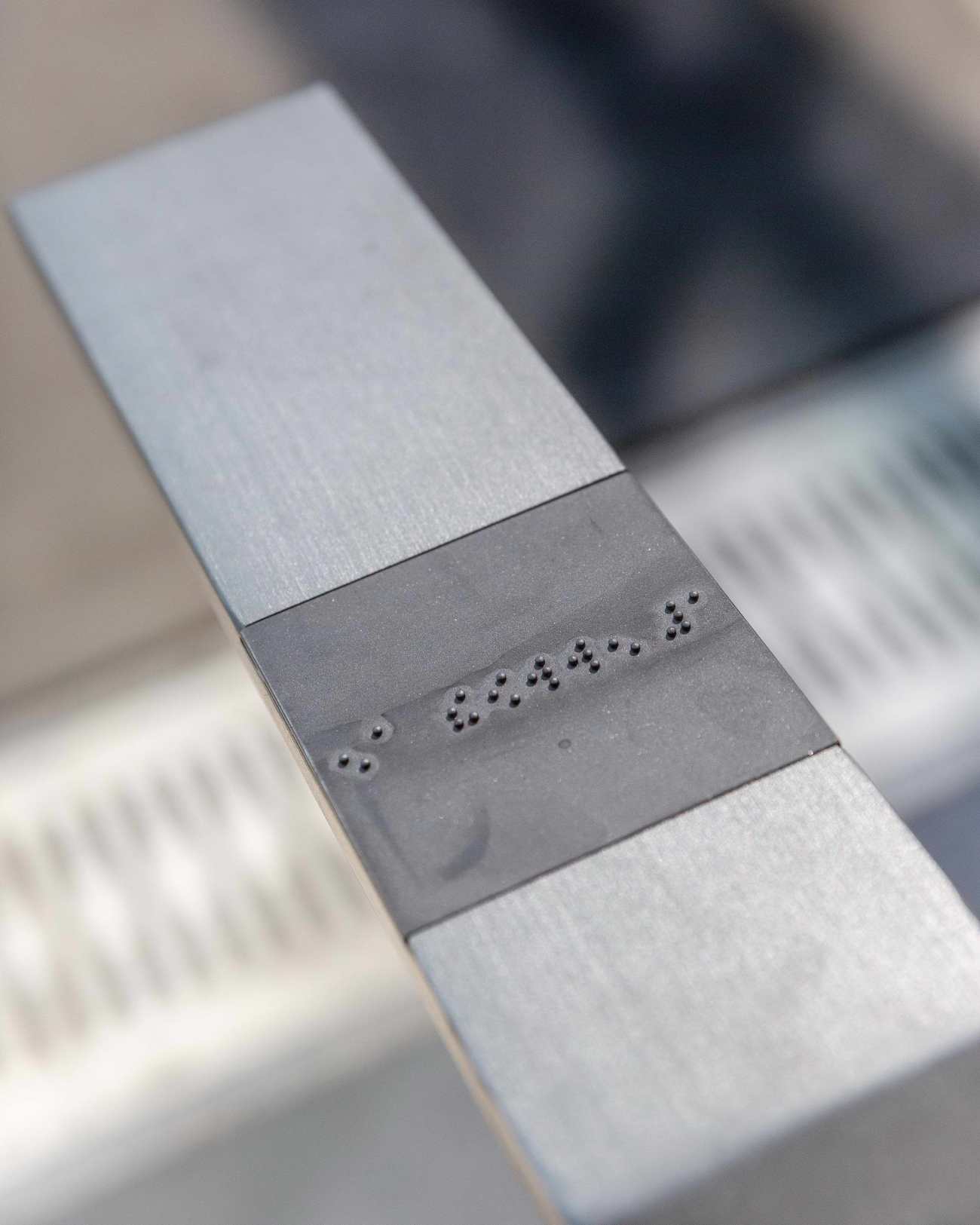 | 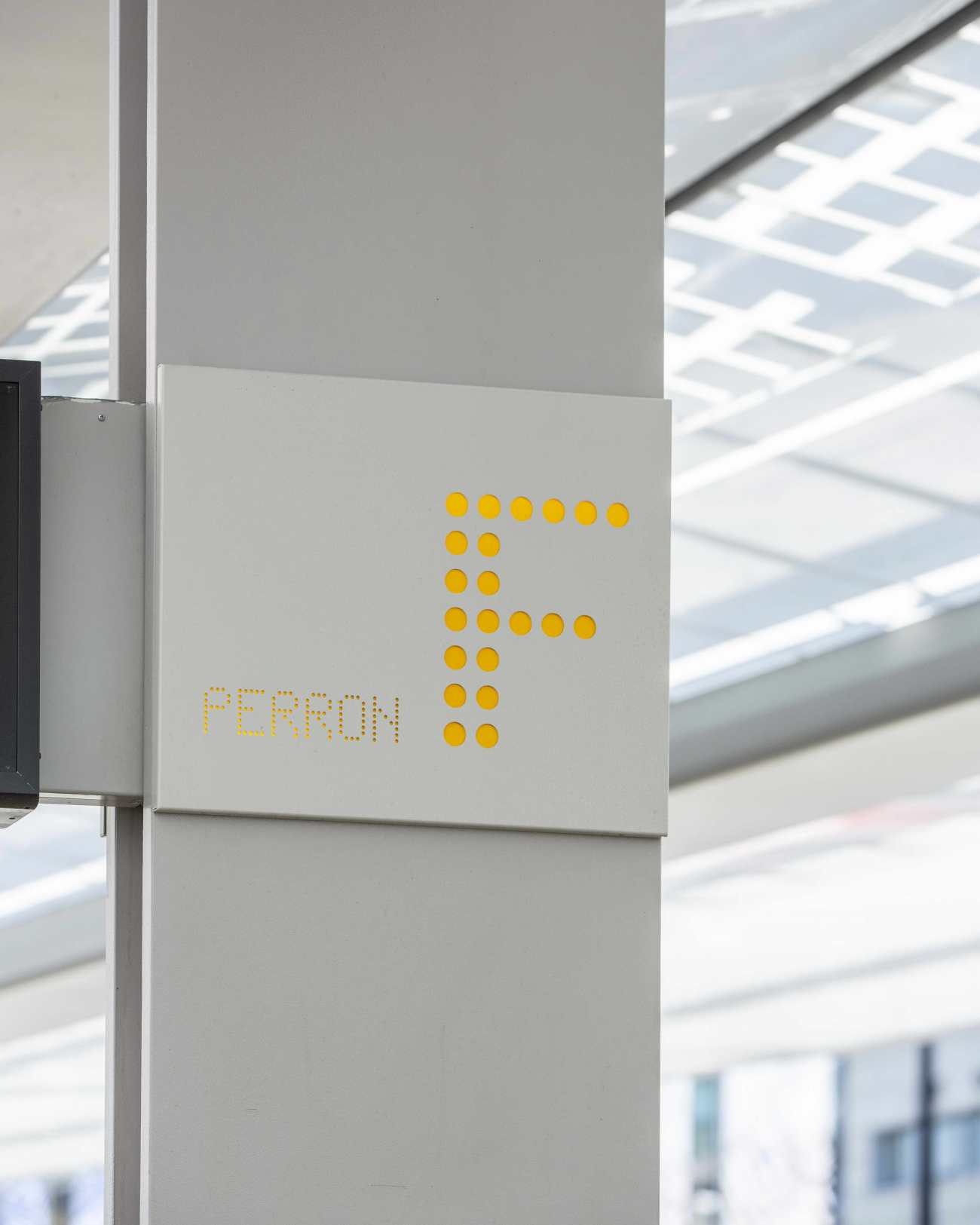 |
Project: bus station Tilburg
Address project: Spoorlaan, Tilburg
Client: City council Tilburg
Architect: architectenbureau cepezed, Delft
Structural engineering: IMd Raadgevende Ingenieurs, Rotterdam
Consultant mechanical & electrical engineering: Nelissen Ingenieursbureau b.v., Eindhoven
Consultant building physics, fire safety and Sustainability: Nelissen Ingenieursbureau b.v., Eindhoven
Landscape architect/urban planner: Atelier Quadrat, Rotterdam
Lighting: Atelier LEK, Rotterdam
Main contractor: BAM Infra bv, Gouda
Contractor steel construction: Buiting Staalbouw, Almelo
Contractor installations: Hoppenbouwers Techniek, Udenhout
Etfe roof: Buitink - Technology, Duiven
Design phase: October 2016 – September 2017
Construction phase: March 2018 – March 2019
Length and width | gfa building: 160 m en 30 m (at widest point) | 108m² bvo
Sustainability: 250 m² of solar panels on the roof; yield = NOM (zero use on the electric bill)
Photography: cepezed | Lucas van der Wee
更新日期:2021-06-04 13:05:33
非常感谢 cepezed 带来的精彩项目, 查阅更多Appreciations towards cepezed for sharing wonderful work on hhlloo. Click to see more works!





